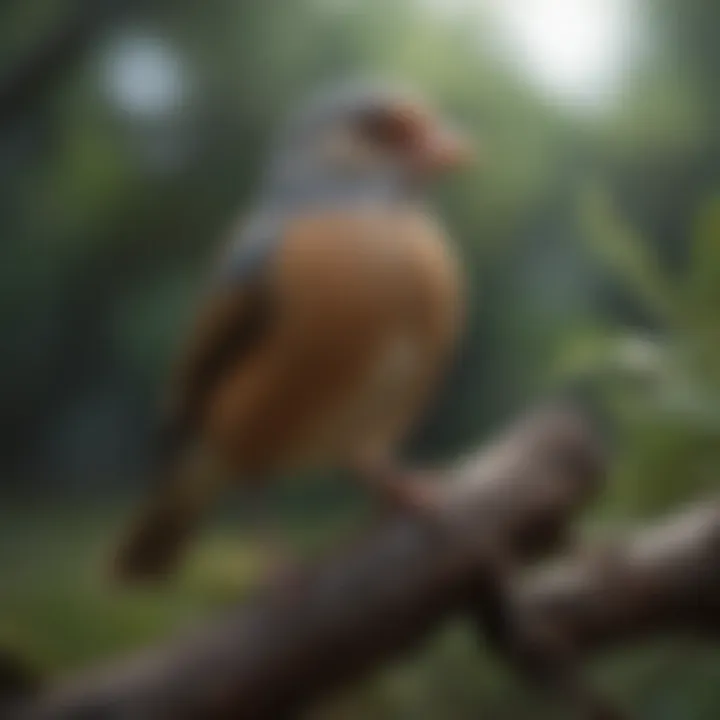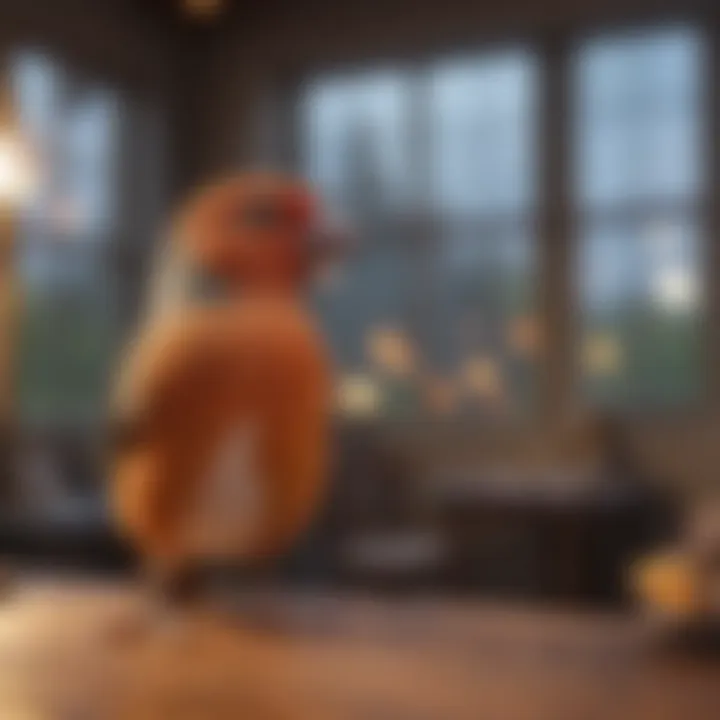Choosing Serene Pet Birds for Informed Owners


Intro
Choosing a pet bird often entails considering a myriad of factors, not least of which is their noise level. For many, the idea of a melodious chirp sounds delightful, but for others, a quieter companion is a necessity. Selecting a pet bird that aligns with the need for tranquility requires delving into their specific characteristics, lifestyles, and social needs. This article aims to provide keen insights for both the first-time bird owner and the seasoned aficionado. By focusing on the gentle souls of the avian world, we set the stage for a more peaceful home environment.
Care Tips
When it comes to pet birds, understanding their care requirements is crucial. Each bird species has its own unique needs, and accommodating those ensures a harmonious relationship.
Daily Care Routines
The foundation of a healthy bird is a routine. Birds, like children, thrive on consistency. Morning rituals often include feeding, which should be a mix of fresh fruits, vegetables, and high-quality pellets. Contrary to common myths, birds aren’t solitary by nature. They crave interaction, so setting aside time each day for socialization is key.
Cage Setup and Maintenance
Setting up a proper cage is akin to creating a home within a home. An ideal cage should be spacious enough for them to stretch their wings and have a variety of perches at different heights. Ensuring that the cage is equipped with an assortment of toys is essential to keep your bird mentally stimulated. Regular maintenance is a must; a thorough cleaning at least once a week is recommended to ward off germs and ensure a pleasant living environment.
Hygiene and Cleaning Practices
Birds are naturally neat creatures, but their environment requires diligence. Hygiene goes beyond the daily checks. Owners should take care to clean food and water dishes daily, while the cage should be deep-cleaned routinely. An effective cleaning solution can be made from diluted vinegar, a natural disinfectant that's safe for birds.
Seasonal Care Adjustments
As seasons change, so do the needs of your pet. During colder months, consider adding more bedding for warmth and monitoring drafts near the cage. In contrast, summer might require a fan to ensure adequate airflow—just be sure it isn’t directly blowing at your feathered friend, as they can be sensitive to cold drafts.
Behavioral Insights
Knowing how to interpret bird behavior can transform potential challenges into fruitful interactions.
Understanding Bird Body Language
A bird's body language speaks volumes. The way they ruffle their feathers, tilt their heads, or even the position of their tails can serve as indicators of mood. For example, a puffed-up bird may be cold or ill, while a playful head tilt often signals curiosity.
Common Behavioral Issues and Solutions
Issues like excessive screaming or biting can arise from boredom or stress. If a bird begins to squawk excessively, check their environmental stimulation. Perhaps they require more toys or attention. Gradually introducing new activities can often remedy such behavioral concerns by keeping the little critters engaged.
Positive Reinforcement Techniques
Using treats effectively can cement positive behaviors. A gentle approach to shaping their behavior can include rewarding them with a favorite snack when they exhibit desired actions. This teaches them that good behavior translates to good rewards—an age-old lesson that works wonders.
Social Interaction Needs
Birds are social animals and enjoy interaction, either with their owners or with other birds. Engaging them daily fosters not only trust but also creates a bond that enhances their overall well-being. Setting up a structured playtime each day encourages your bird to come out of the cage and explore their surroundings in a safe environment.
Nutrition Guides
A carefully balanced diet is essential for keeping your bird healthy and vibrant.
Essential Diet Components
Birds thrive on a variety of foods. A good staple involves high-quality pellets that offer balanced nutrition. Fresh fruits and vegetables supplement this, promoting better physical and mental health. Try to incorporate colorful options like bell peppers, carrots, and leafy greens.
Safe and Toxic Foods
While many foods are safe, some can be harmful or even fatal. For instance, avocado and chocolate are toxic to birds, so these should be avoided at all costs. Keeping a list of safe and toxic foods handy can be incredibly useful.
Supplements and Treats
Bird treats should complement their diet rather than substitute for it. Seeds and nuts are favorites but should only be offered in moderation because of their high-fat content. A bird's need for variety means occasional treats can also be made from safe fruits and veggies.
Feeding Strategies for Different Species
Larger parrots tend to have different dietary needs compared to smaller species like finches. For example, African grey parrots benefit from a diet rich in seeds and nuts, while budgerigars enjoy a mix that includes greens and some hard grains. Tailoring their feeding strategy according to species will ensure optimal health.
Wellness and Health
Ensuring your bird's health requires vigilance and regular attention.
Routine Health Checkups
At the very least, a yearly visit to an avian veterinarian should be on the calendar. Just as you would for a dog or cat, routine checkups can catch potential health issues before they become serious problems.
Identifying Symptoms of Illness
Learning to recognize signs of distress or illness, such as lethargy or changes in droppings, can be lifesaving. Observing your bird closely will allow you to detect any anomalies early and seek appropriate care.
Preventative Care and Vaccinations
Preventative measures can include maintaining a clean environment and ensuring that your bird is free from stress, which can lead to illness. Discuss vaccinations with your vet as they can offer guidelines best suited for your specific bird species.
Mental and Emotional Well-being
Just as physical health is crucial, so is mental well-being. Ensuring that birds have opportunities for enrichment will help mitigate feelings of anxiety or depression, which can manifest in destructive behaviors.
Enriching Activities
Keeping pet birds entertained goes a long way toward improving their quality of life.


Toys and Playtime Ideas
Rotate toys regularly to maintain interest. For creative individuals, making DIY toys can be fun and stimulating for the bird. Use simple household materials to create engaging puzzles that enhance their inquisitive minds.
Training and Tricks
Training not only provides mental stimulation; it also deepens the bond between you and your bird. Simple commands like "step up" or "wave" can easily become part of your routine, offering both fun and learning.
Outdoor Activities and Interaction
Supervised outings can provide new stimuli. Birds can benefit from fresh air and sunshine, so consider a suitable outdoor cage or harness for short excursions.
DIY Projects for Mental Stimulation
Crafting simple puzzles that encourage problem-solving can be an engaging activity for both you and your pet. Examples could include hiding treats in a rolled-up towel or fabric, allowing the bird to forage its way to the reward.
Creating a serene environment for your quieter avian companions not only enhances their quality of life, but it also allows discerning owners to fully enjoy the symphony of tranquility that comes with these remarkable creatures.
Understanding Pet Birds
Understanding pet birds is crucial for anyone considering bringing one into their home. Birds are not just colorful additions; they are companions with unique personalities. They offer affection, entertainment, and even intelligence—attributes that are well-suited for discerning owners seeking a quieter lifestyle. Grasping the various aspects of pet birds helps in ensuring their well-being, which in turn creates a harmonious environment for both the bird and owner.
The Appeal of Avian Companionship
The allure of having a bird as a pet lies in their vibrant presence and the bond that can develop over time. Birds can be surprisingly affectionate, forming strong attachments to their human companions. Unlike cats or dogs, however, they require a more tailored touch, demanding attention and interaction while also needing their own space. They are excellent listeners—sometimes even better than our closest friends—quietly providing a sense of comfort and companionship.
Factors Influencing Bird Noisiness
Understanding what makes some birds noisier than others is essential for making an informed choice. It’s not just about the species; several other factors contribute to a bird’s vocalization.
Species-specific behaviors
Each bird species has its set of behaviors that can affect how much noise it produces. For instance, parakeets are notoriously chatty, while canaries tend to chirp more melodically and less frequently. Knowing these traits can guide potential owners in selecting a bird that fits their idea of tranquility.
The main characteristic that stands out in species-specific behaviors is the innate vocalization tendencies of the bird. Some birds, such as cockatiels, will whistle and try to mimic sounds, while others might be more reserved. Taking the time to understand these differences not only makes a difference in selecting a breed but ensures a better fit for a quieter lifestyle.
Environmental triggers
Birds are sensitive creatures; their loudness can often be influenced by their surroundings. Loud noises from everyday activities or sudden movements can cause birds to react vocally—sometimes out of fear or excitement. By making thoughtful modifications in their environment, like creating a calm nook or utilizing soft lighting, owners might reduce these triggers and thereby the overall noise.
A unique feature of environmental triggers is how birds react to human activity. If chores are being done around them, they may join in with unsolicited cacophonies. This aspect reinforces the importance of a tranquil living space, essentially transforming your home into a sanctuary, ensuring birds feel secure.
Socialization impacts
The level of socialization a bird receives can greatly influence its noise levels. Birds are naturally social animals that thrive on interaction. A well-socialized bird may engage in quieter forms of communication, whereas one that is lonely may call out more often in search of interaction. Understanding the distinctive social needs ensures that the owner can provide sufficient companionship to their feathered friends.
Moreover, socialization impacts the type of vocalization a bird will adopt. Birds that interact frequently with humans often mimic human speech or sounds, which may not always be undesirable but adds to the overall ambience in the house. Yet, a lack of interaction might lead to a more vocal bird seeking attention. -
In essence, by identifying these factors, owners can create a nurturing atmosphere that resonates with tranquility, allowing for peaceful coexistence with their avian companions.
Identifying Quiet Bird Species
When one decides to welcome a feathered friend into their home, the question often arises: which species will keep the peace? Identifying quiet bird species is paramount for owners who desire a tranquil environment. For those with a discerning taste, understanding the various characteristics of less vocal birds is crucial.
Choosing the right bird goes beyond personal preference; it’s about matching the animal's natural behaviors with the dynamics of your household. The quieter avian companions can offer companionship without the cacophony typical of more vocal species, making the selection process a vital aspect of pet ownership. In this section, we will delve into specific low-noise breeds, evaluate sound levels, and outline critical factors to consider while selecting a suitable pet bird.
Top Low-Noise Bird Breeds
Parakeets
Parakeets, also known as budgerigars, are favored for their vibrant personalities while being relatively quiet. These sociable creatures are known to be affectionate and interactive, making them excellent companions for individuals or families alike. Their playful nature does encourage chirping, yet, compared to other breeds, the sound is light and usually not overwhelming.
A remarkable feature of parakeets is their ability to mimic sounds, which can be delightful but also leads to a slight uptick in their volume if not properly managed. Still, their chirps are typically dainty, especially if they are kept in a calm environment, allowing them to thrive without excessive noise. Furthermore, with proper training and socialization, parakeets can be taught to be quieter, promoting a good balance in the household.
Canaries
Canaries boast a gentle demeanor and offer a soothing presence in any home. They are featured for their colorful plumage and sweet songs, yet, it’s key to note that not all canaries sing heartily. American Singers, for example, are known for their melodious sounds, but if you desire a quieter option, consider the German Roller or the Spanish Timbrado, both of which provide lovely music without being too loud.
One significant advantage of canaries is their independent nature. They can be content without constant interaction, making them paired well with busy individuals or families. While their songs are enchanting, they do tend to be calmer than many of their counterparts. This makes them a popular choice for those wanting a serene atmosphere.
Doves
Doves are often serene and composed creatures, well-regarded for their soft cooing sound. While they may engage in light vocalizations, it’s far less intrusive compared to other species, making them a commendable option for quiet homes. They are gentle and tend to bond closely with their owners, establishing a companionship that is characterized by peace.
A dedicated feature of doves is their peaceful nature—they thrive when calm, favoring less chaotic environments. Their low-level cooing can be soothing, creating a serene ambiance in your living space. However, they can become stressed if kept near loud noises or disruptive environments, so some forethought is essential when integrating them into your home.
Evaluation of Sound Levels
Comparative analysis of species
When considering a pet bird, a comparative analysis of species plays a pivotal role in understanding not just their vocal tendencies but also how these sounds fit into the household environment. Different species naturally carry varying sound levels that can affect daily life, and diving into these differences helps to make informed decisions.
Birds like cockatiels or amazon parrots are notoriously loud, with calls that can echo through a home. On the flip side, parakeets and canaries maintain a lower pitch and softer volumes, which makes them more suitable for serene living environments. This comparative analysis allows owners to weigh the implications of sound against their own living habits, preferences, and expectations of companionship.
Sound frequency considerations
Sound frequency considerations provide insight into how sound travels and affects perception. Low-frequency sounds tend to be more resonant and can often feel more invasive, while higher frequencies, which can be characteristic of certain bird species, may not disturb as much but can still be irritating over extended periods.
Understanding frequencies helps identify which birds may be more suitable for various living scenarios. For example, scaly-breasted lorikeets tend to emit high-pitched sounds while doves produce lower, mellow coos. Owners looking for companionship that harmonizes with a calm living space will benefit greatly from considering sound frequency alongside volume.


This discerning consideration enables bird enthusiasts to live in tranquility with their avian companions—allowing the joys of pet ownership without fear of noise disrupting the peace.
Behavioral Insights
Understanding the behaviors of quieter pet birds is paramount for those looking to increase harmony within their homes. This section delves into the various social dynamics and distinct cues these birds exhibit. By discerning their behaviors, one can not only enhance the quality of life for their feathered companions but also create an atmosphere beneficial for both birds and owners alike.
Social Dynamics of Quieter Birds
Group vs. Solitary Behavior
When considering group versus solitary behavior, there’s much to uncover. Many quieter bird species tend to thrive in groups; they possess a natural inclination to interact with fellow birds. This social stimulation is essential, not just for their emotional well-being but also for their overall mental health. A key characteristic here is the comfort that companionship brings. Birds like budgerigars are often seen flocking together, an innate tendency that makes them naturally more content in a group setting.
On the other hand, some birds, such as finches, may prefer solitary environments while still being relatively quiet. The unique feature of solitary behavior is that it allows individuals to display distinct personalities without feeling overwhelmed by others. However, this can also have its downsides; a solitary bird might become lonely and engage in stress behaviors without social interaction. Therefore, it's crucial for potential owners to weigh these aspects carefully when selecting a feathered friend.
Communication Patterns
Diving into communication patterns shows a fascinating side of quieter birds. Unlike many noisy breeds, these birds can express themselves in subtle ways. Their communication tends to rely heavily on body signals and soft vocalizations rather than loud calls. One significant characteristic here is their use of non-verbal cues which often reflects their mood and intentions. Quiet birds have an exquisite ability to communicate with their owners without being disruptive, which is generally a desirable trait in a pet.
While quieter birds converse in softer tones, such as chirps or whistles, the challenge lies in understanding these nuanced sounds. Owners may need to become attuned to the specific way their bird interacts, learning to read between the lines of quiet chirps. The main advantage is that this type of communication can foster a closer bond as owners adapt to their birds’ styles, leading to an enriched relationship between them.
Understanding Cues and Communication
Body Language
Body language in birds is a rich area for exploration. Observing a bird's posture, head movements, and wing placements provides valuable insight into their emotional state. For instance, when a bird fluffs up its feathers, it’s typically a sign of relaxation or contentment, whereas a hunched position could indicate fear or discomfort. This non-verbal communication is a key characteristic of quieter birds, as it often allows owners to gauge their pet's feelings without overwhelming noise.
One unique aspect of body language is that it can vary from species to species. For example, cockatiels tend to have expressive tails that display a variety of emotions ranging from excitement to submission. While charming, it also highlights the need for owners to familiarize themselves with their specific bird’s quirks, leading to an immersive understanding of their behaviors.
Vocalization Nuances
Vocalization nuances are equally intriguing and essential for owners to comprehend. Although quieter species aren’t notorious for raucous sounds, they often engage in soft murmurs, whistles, or gentle chirps. A significant characteristic of these soft vocalizations is their ability to convey a range of moods, from happiness to inquisitiveness.
These subtle sounds, while quiet, can sometimes present challenges. For instance, owners might find it difficult to interpret a single chirp versus multiple chirps. Learning this can take a bit of time; however, it ultimately enhances the bond between the bird and its owner. The advantage is that quieter vocalizations are less intrusive and allow for a peaceful living environment, which corresponds directly to the goal of selecting low-noise avian companions.
Creating a Peaceful Environment
A serene environment serves as the foundation for a happy and stress-free life for both pet birds and their owners. When selecting quiet pet birds, one must pay attention to how their surroundings can contribute to their tranquility. The right atmosphere not only promotes the well-being of your feathered friends, but also enhances the quality of life within your home. The benefits of creating a peaceful environment span from behavioral stability to nurturing a lasting bond between birds and their owners.
Environmental Modifications
Optimal cage placement
The placement of a bird's cage is crucial to its comfort and overall behavior. Placing the cage in a quiet area away from heavy foot traffic and loud noises can significantly contribute to a calm environment for the bird. Birds, being sensitive creatures, often get stressed in chaotic surroundings, which can lead to excessive vocalization or even health issues.
One standout feature of optimal cage placement is its potential to reduce external disturbances. By situating the cage near windows or in visually appealing spots, you allow your bird to engage with its surroundings in a peaceful manner while still feeling secure. A popular choice for many owners is to place the cage in a communal area of the house, where it can bask in the warm glow of family life but still maintain a comfortable distance from high-energy activities.
The drawbacks include making sure that direct sunlight doesn’t hit the cage too strongly or that it’s not in a drafty zone. Finding that sweet spot can make all the difference in fostering a serene habitat.
Reducing stressors
Reducing stressors is equally essential in maintaining a calm environment. Common stressors can include loud noises, sudden movements, and even other pets. Being considerate of these factors is an integral part of pet ownership, more so for bird owners, who have to manage the delicate comedic cues that birds exhibit.
Key characteristics of reducing stressors entail the introduction of soft furnishings and soundproofing to limit external noise. Additionally, providing a consistent routine helps birds feel secure, knowing what to expect throughout their day. This approach gives them a sense of control over their environment.
The uniqueness lies in observing your bird’s reactions and adjusting as needed. For instance, some birds thrive with a few other birds around while others prefer solitude. This tailored approach can be excellent for individual needs, although it sometimes requires trial and error.
Enrichment Strategies
Toys and Activities
Enrichment strategies play a significant role in ensuring that your quiet pet birds remain mentally and physically stimulated without becoming overly noisy. Engaging with toys and activities can help channel their energy positively. This resourceful engagement may include manipulating toys that require problem-solving or simple foraging games to keep them occupied.
The adaptability of toys is particularly beneficial since they come in various forms—natural wood perches, swinging toys, and even puzzles created for birds. Each type of toy encourages mental agility, which in turn fosters a calm demeanor, as birds with active minds are less likely to engage in loud, repetitive behaviors out of boredom.
However, remember that not all toys work for every bird. Some might prefer simpler offerings rather than complex setups, thus emphasizing the importance of understanding what best suits your bird's personality.
Social interaction methods
Social interaction methods also hold a pivotal position in maintaining a peaceful atmosphere. Birds are inherently social animals and need positive interaction with both people and their kind. Regular gentle interaction through talking, training, or even singing creates emotional bonds while curtailing unnecessary vocalization.
The hallmark of social interaction lies in its balance; while birds love companionship, overexposing them can lead to stress. Finding ways to interact without overwhelming them—perhaps spending a focused fifteen minutes in the morning or evening—can create a zen experience for both the bird and its human.
Ultimately, understanding your bird's social needs can contribute greatly to a serene coexistence and reduce the likelihood of distress that can result in cacophony.
In summary, cultivating a peaceful environment requires thoughtful modification and keen observation. Paying attention to the subtle details can help craft a space that not only meets the needs of quiet pet birds but also elevates the overall living experience.
Nutrition for Calm Birds
When it comes to quiet pet birds, their diet plays a pivotal role in maintaining not just their physical health but also their overall temperament. A well-balanced nutrition plan can significantly impact their mood, behavior, and subsequent vocalization. In environments where peace and quiet are prioritized, focusing on the dietary needs of these avian companions ensures that they remain calm and content. Understanding what goes into their food, along with its effects, is essential for discerning owners seeking harmony in their homes.
Understanding Dietary Needs
Birds, like all pets, have specific nutritional requirements that must be met for optimal well-being. It's crucial to provide a mix of high-quality pellets, seeds, fresh fruits, and vegetables. Here's a quick look at the essential components:
- Pellets: Formulated to provide complete nutrition, pellets often contain essential vitamins and minerals. They help reduce the need for excessive seed consumption, which can lead to obesity and other health issues.
- Seeds: While seeds are a favorite among many birds, they should make up only a small part of the diet. They are often high in fat, which can lead to poor health if overfed.
- Fruits and Vegetables: Fresh produce can be a great source of vitamins and help keep a bird hydrated. Include a variety of colors to ensure a wide range of nutrients.
Pay close attention to individual species' needs, as some might have specific dietary restrictions or preferences. For example, while budgerigars thrive on a high seed diet, cockatiels require more vegetables to maintain their health. Tailoring diet to species is crucial in helping birds achieve a calm demeanor; nutrition impacts everything from energy levels to stress responses.


Supplements for Stress Reduction
In some cases, the standard diet may not be sufficient to address stress in birds. That's where supplements come in. They can fill gaps in nutrition and also provide specific benefits that promote a sense of well-being. Consider the following:
- Omega-3 Fatty Acids: Found in certain oils like flaxseed oil, these can help reduce inflammation and promote healthy skin and feathers, aiding overall comfort.
- Probiotics: These beneficial bacteria support gut health. A healthy gut can reduce anxiety in birds, which helps minimize stress-related vocalizations.
- Vitamins: Vitamin C and B-complex vitamins can alleviate stress reactions and improve general health when added in moderation.
"A bird's mood is a reflection of its diet; what fills their stomach can often fill their hearts as well."
Before introducing any supplements, it’s wise to consult with avian veterinarians. They can offer personalized advice tailored to your bird's specific needs and challenges. Remember, a calm bird is often a well-nourished bird.
Health and Wellness Considerations
When it comes to caring for pet birds, health and wellness play a critical role that cannot be overlooked. Choosing a quiet bird is just one part of the equation; understanding their specific health needs ensures that they enjoy a long, vibrant life in your home. Not only does it contribute to the bird's overall well-being, but it also enhances the pet-owner relationship—a truly symbiotic connection. Thus, recognizing these needs is paramount in creating a peaceful and nurturing environment.
One of the key elements of health and wellness for pet birds is preventive health care. By focusing on preventative measures, owners can fend off potential ailments before they become more serious issues. This includes regular check-ups with an avian vet, maintaining proper diet, and observing their exercise habits.
Additionally, being attuned to behavioral changes can greatly improve the chances of catching health issues early. Birds can be masterful at masking their discomfort, so paying close attention to their everyday behaviors is essential. An apparent decrease in chirping or unusual fluffing of feathers can signal underlying distress.
Preventive Health Care
Preventive health care involves a proactive approach to bird ownership, similar to how one would care for a child or even a dog. A regular veterinary examination is vital, ideally performed every six months, to track weight, feather condition, and signs of any illness.
Creating an environment that deters health issues begins with proper housing and nutrition. Ensuring adequate space in the cage, introducing a variety of seeds, pellets, and fresh fruits, and avoiding toxic substances—like certain houseplants—are essential steps.
Furthermore, maintaining a clean living space goes a long way in keeping your feathered friend healthy. Regularly cleaning the cage, providing clean water, and ensuring toys and perches are safe and sanitized is the foundation of preventive health care.
Recognizing Behavioral Changes
Birds, by nature, are creatures of habit. Any deviation from their usual behavior may suggest something isn’t quite right. Recognizing these behavioral shifts can be the difference between catching a health issue early or needing a veterinary emergency.
Signs of distress
Signs of distress in birds can manifest in various ways: excessive preening, lethargy, or sudden aggression. Such behaviors can indicate underlying issues, maybe even stress-related. Observing these signs helps one stay ahead of potential problems. For example, if a bird that usually loves to socialize begins to isolate itself, this could be a critical indicator of emotional or physical distress.
It's essential to understand that these signs act as a communication tool. A bird’s way of signaling that something is amiss in its world is crucial for owners. Addressing these behaviours early can prevent aggravation of the issues. For instance, if the distress is due to environmental factors, modifications can be made.
Indicators of health issues
Recognizing indicators of health issues is also paramount for caring for quiet birds. If a pet exhibits unusual feather loss, weight fluctuations, or changes in droppings, these might be clear messages of health problems at play.
Birds do not show discomfort like most animals do; hence a keen eye for these signs becomes vital. Understanding these behavioral indicators helps owners make educated decisions about their pet's well-being. Promptly addressing significant indicators increases the likelihood of effective treatment and enhances the overall quality of life for the bird. Keeping comprehensive records and consulting with a veterinarian can play a significant role in addressing these concerns effectively.
In sum, focusing on health and wellness is foundational for the well-being of any pet bird. Thriving quiet birds not only enhance the atmosphere of a household but also enrich the lives of their owners immensely.
The Benefits of Choosing Quiet Birds
Selecting quiet pet birds can significantly enhance the overall atmosphere of a home. For many potential bird owners, the allure of avian companionship is often mixed with concerns about noise. Embracing quieter species can lead to a more harmonious living environment, making it an important consideration for discerning owners seeking tranquility.
One key benefit lies in the simplicity of coexistence with quieter birds. While many bird species can be vocal, opting for birds known for their gentle chirps or soft coos ensures that household noise levels remain manageable. This can be especially crucial for those living in apartments or close quarters, where sound can travel far and wide.
Moreover, quieter birds have the potential to foster a more relaxing atmosphere in the home. Unlike louder species, which might contribute to heightened stress levels, calm avian companions encourage a sense of muted serenity. Homeowners can enjoy activities such as reading, working, or watching television without the interruption of sharp squawks. This overall peace encourages a mindful lifestyle, elevating the experience of pet ownership.
Enhancing Living Spaces
Quiet birds can transform living spaces into serene sanctuaries. For enthusiasts of interior design, the presence of a bird can enhance aesthetic appeal without overwhelming the senses. Choosing a soft-spoken species allows their charming presence to be a delightful addition rather than a source of distraction.
In addition to visual appeal, the interaction with a quiet bird promotes a sense of calmness that permeates the entire environment. Imagine a sunbeam pouring into a cozy room, the soft rustle of feathers, as a quiet canary sits perched in its beautifully designed cage. The ambiance becomes inviting—a perfect setting for friends and family.
- Cage Placement: Positioning the cage in a tranquil corner of the room can optimize comfort for both the birds and humans alike. Avoiding high-traffic areas helps maintain a sense of tranquility for the birds, reducing any potential stress.
- Natural Sounds: Quieter bird species like finches or budgerigars contribute to a gentle symphony of soft chirps, providing a peaceful background without causing a ruckus. These subtle sounds can enhance focus and relaxation for everyone in the home.
Positive Impact on Household Dynamics
The inclusion of quiet birds in a household can also positively influence family dynamics. In homes where multiple pets reside, a quieter bird can seamlessly blend into the existing environment without disrupting harmony. Their gentle demeanor often helps balance the energy levels of more energetic or vocal pets.
Furthermore, quiet birds can encourage bonding within families. Children, for example, can learn valuable lessons about responsibility and compassion through the care and interaction with peaceful pets. This shared experience fosters both patience and nurturing qualities among family members.
- Interaction Opportunities: Families will discover unique ways to interact with their birds quietly. Teaching the birds tricks, talking lightly, or simply enjoying their company can create lasting memories without overwhelming noise.
- Mindful Living: Engaging with a calm bird can serve as a reminder to slow down. In our fast-paced world, the act of tending to a bird encourages mindfulness, promoting a lifestyle that values tranquility.
"Choosing a quiet bird isn't just about noise control; it's about creating an enriched living experience for both human and avian companions."
With these benefits in mind, selecting a tranquil pet bird emerges as a thoughtful choice for those wishing to cultivate peace within their homes. Whether for aesthetic enhancement or fostering family bonds, the quiet avian option can meet various desires and needs of discerning owners.
Ending
The choice of quiet pet birds is an important consideration for those who seek companionship without the incessant noise that many birds can produce. This article has delved into the nuances involved in selecting the right feathered friend for a peaceful home. By understanding avian behavior, identifying quiet bird species, and ensuring their environment supports tranquility, we can create a harmonious living space not only for the birds but also for ourselves.
Choosing quieter species, such as certain breeds of canaries or doves, allows owners to enjoy the vibrant presence of birds while minimizing disruptive sounds. When one understands the factors that influence noise levels, such as environmental triggers and social dynamics, the ability to select a suitable bird becomes clearer.
Moreover, the advantages of having a quiet bird extend beyond simple sound levels. A calm avian companion can enhance the quality of life within the household, fostering a more serene atmosphere conducive to relaxation and stress relief. It is essential for potential bird owners to consider what they want from a pet bird and the level of care required to support a tranquil environment.
In sum, the selection process of quiet pet birds involves careful thought and consideration, leading to fulfilling relationships between avian companions and their human guardians.
Summary of Key Insights
- Understanding Avian Companionship: Pet birds offer emotional support and joy, but not all species are suitable for quiet living environments.
- Species-Specific Behaviors: Some birds are inherently quieter than others. For example, doves are generally low in vocal volume compared with more talkative companions like parrots.
- Environmental Influence: The surroundings of a bird play a crucial role in its behavior and sound levels. Reducing stressors in their habitat can lead to a calmer avian experience.
- Benefits of Quiet Birds: Quieter species tend to have a positive impact on household dynamics, reducing noise-related stress for all inhabitants.
Encouragement for Responsible Ownership
As you contemplate the introduction of a bird into your home, remember that responsible ownership begins before the purchase. Researching the specific needs of the species you fancy is essential. Ensure that you are prepared to create an environment conducive to their well-being, which includes noise management.
Part of responsible bird ownership involves understanding that these pets require social interaction, mental stimulation, and emotional support. It is essential to facilitate an enriching environment through toys, proper care, and opportunities for socialization.
In addition, it’s invaluable to be prepared for the long-term commitment these animals entail. Birds can live for many years, and their needs will change over time. Keeping your expectations realistic and embracing the responsibilities associated with bird care can lead to a rewarding experience that fosters a deep bond between owner and pet.
By choosing quietly bred avians and fostering a nurturing atmosphere, you not only benefit from their serene presence but also contribute to their health and happiness. The quieter life you aspire for can indeed be achieved with the right choices and a commitment to understanding these beautiful creatures.















